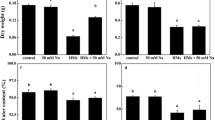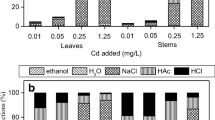Abstract
To better monitor and remediate environments contaminated by cadmium (Cd), plants are used as hyperaccumulators or biomonitors; however, few have been identified for aquatic Cd pollution. In our study, two aquatic ornamental plants, Microsorum pteropus (Blume) Copel. and Echinodorus grisebachii Small, were studied for their Cd accumulation capacity, morphological characteristics, and leaf physiological indexes. Microsorum pteropus (Blume) Copel. leaf has the potential to hyperaccumulate Cd (166 mg/kg dry weight for 1 mg/L exposure), with no significant physiological difference under exposure. Echinodorus grisebachii Small had sensitive diagnostic responses to Cd toxicity, such as significant decreases in Chl (a + b) and Chl-a/b, increased peroxidase (POD) activity, greater malondialdehyde (MDA) content, and increased soluble sugar content. These results suggest that Microsorum pteropus (Blume) Copel. could have the potential to be a Cd hyperaccumulator, while Echinodorus grisebachii Small could serve as a biomonitor for Cd-contaminated water bodies.






Similar content being viewed by others
References
Alscher RG, Hess JL (1993) Antioxidants in higher plants. CRC Press, Boca Raton
Aravind P, Prasad MNV (2003) Zinc alleviates cadmium-induced oxidative stress in Ceratophyllum demersum L.: a free floating freshwater macrophyte. Plant Physiol Biochem 41:391–397
Arnon DI (1949) Copper enzymes in isolated chloroplasts. Polyphenoloxidase in Beta vulgaris. Plant Physiol 24:1
Arnot JA, Gobas FA (2006) A review of bioconcentration factor (BCF) and bioaccumulation factor (BAF) assessments for organic chemicals in aquatic organisms. Environ Rev 14:257–297
Baker A, Reeves R, Hajar A (1994) Heavy metal accumulation and tolerance in British populations of the metallophyte Thlaspi caerulescens J. & C. Presl (Brassicaceae). New Phytol 127:61–68
Baker AJ, Brooks R, Pease A, Malaisse F (1983) Studies on copper and cobalt tolerance in three closely related taxa within the genus Silene L.(Caryophyllaceae) from Zaïre. Plant Soil 73:377–385
Basa B, Lattanzio G, Solti Á, Tóth B, Abadía J, Fodor F, Sárvári É (2014) Changes induced by cadmium stress and iron deficiency in the composition and organization of thylakoid complexes in sugar beet (Beta vulgaris L.) Environ Exp Bot 101:1–11
Bert V, Meerts P, Saumitou-Laprade P, Salis P, Gruber W, Verbruggen N (2003) Genetic basis of Cd tolerance and hyperaccumulation in Arabidopsis halleri. Plant Soil 249:9–18
Bonanno G (2013) Comparative performance of trace element bioaccumulation and biomonitoring in the plant species Typha domingensis, Phragmites australis and Arundo donax. Ecotoxicol Environ Saf 97:124–130
Bonanno G, Di Martino V (2016) Seagrass Cymodocea nodosa as a trace element biomonitor: bioaccumulation patterns and biomonitoring uses. J Geochem Explor 169:43–49
Bradford MM (1976) A rapid and sensitive method for the quantitation of microgram quantities of protein utilizing the principle of protein-dye binding. Anal Biochem 72:248–254
Brooks R, Lee J, Reeves RD, Jaffré T (1977) Detection of nickeliferous rocks by analysis of herbarium specimens of indicator plants. J Geochem Explor 7:49–57
Chiang H-C, Lo J-C, Yeh K-C (2006) Genes associated with heavy metal tolerance and accumulation in Zn/Cd hyperaccumulator Arabidopsis halleri: a genomic survey with cDNA microarray. Environ Sci Technol 40:6792–6798
Das S, Goswami S, Talukdar AD (2014) A study on cadmium phytoremediation potential of water lettuce, Pistia stratiotes L. Bull Environ Contam Toxicol 92:169–174
Durak I, Yurtarslanl Z, Canbolat O, Akyol Ö (1993) A methodological approach to superoxide dismutase (SOD) activity assay based on inhibition of nitroblue tetrazolium (NBT) reduction. Clin Chim Acta 214:103–104
Ederli L, Reale L, Ferranti F, Pasqualini S (2004) Responses induced by high concentration of cadmium in Phragmites australis roots. Physiol Plant 121:66–74
Gorelova SV, Frontasyeva MV (2017) The use of higher plants in biomonitoring and environmental bioremediation. In: Phytoremediation. Springer, pp 103–155
Gounden D, Kisten K, Moodley R, Shaik S, Jonnalagadda SB (2016) Impact of spiked concentrations of Cd, Pb, As and Zn in growth medium on elemental uptake of Nasturtium officinale (Watercress). J Environ Sci Health B 51:1–7
Guo TR, Zhang GP, Zhang YH (2007) Physiological changes in barley plants under combined toxicity of aluminum, copper and cadmium. Colloids Surf B Biointerfaces 57:182–188
Hou W, Chen X, Song G, Wang Q, Chang CC (2007) Effects of copper and cadmium on heavy metal polluted waterbody restoration by duckweed (Lemna minor). Plant Physiol Biochem 45:62–69
IARC (1993) International agency for research on cancer-Summaries & evaluations: Cadmium and cadmium compounds (Group 1). IARChttp://www.inchem.org/documents/iarc/vol58/mono58-2.html (accessed 17.06.01)
ITRC (2010) Phytotechnologies. Interstate Technology & Regulatory Council, Mining Waste Team, Washington, D.C. www.itrcweb.org (accessed 17.06.01)
Kučera T, Horáková H, Šonská A (2008) Toxic metal ions in photoautotrophic organisms. Photosynthetica 46:481–489
Kumar NJI, Hiren S, Kumar RN (2006) Biomonitoring of selected freshwater macrophytes to assess lake trace element contamination: a case study of Nal Sarovar Bird Sanctuary, Gujarat, India. J Limnol 65:9–16
Küpper H, Zhao FJ, McGrath SP (1999) Cellular compartmentation of zinc in leaves of the hyperaccumulator Thlaspi caerulescens. Plant Physiol 119:305–312
Lagriffoul A, Mocquot B, Mench M, Vangronsveld J (1998) Cadmium toxicity effects on growth, mineral and chlorophyll contents, and activities of stress related enzymes in young maize plants (Zea mays L.) Plant Soil 200:241–250
Lan X-Y, Yang B, Yan Y-Y, Li X-Y, Xu F-L (2018) Resistance mechanisms and their difference between the root and leaf of Microsorum pteropus—a novel potential aquatic cadmium hyperaccumulator. Sci Total Environ 616:480–490
Li H (2000) Plant physiology and biochemistry principle and techniques. Higher Education Press, Beijing (in Chinese)
Li M, Zhang LJ, Tao L, Li W (2008) Ecophysiological responses of Jussiaea rapens to cadmium exposure. Aquat Bot 88:347–352
Li S, Liu Y-G, Li Y-L, Xu W-H, Li X (2007) The hyperaccumulating of Scirpus tabernaemontani to Cd and its potential for phytoremediation. Guihaia 27:180–185 (in Chinese)
Liu P, Yang Y, Xu G, Guo S, Wang M (2005) Physiological response of four sourthern herbaceous plants to aluminium stress. Chin J Plant Ecol 29:644–651 (in Chinese)
Liu W, Shu W, Lan C (2004) Viola baoshanensis, a plant that hyperaccumulates cadmium. Chin Sci Bull 49:29–32
Luo L, Sun T, Jin Y (1998) Effects of cadmium stress on lipid peroxidation in wheat leaves. China Environ Sci 18:72–75
Mishra S, Srivastava S, Tripathi R, Govindarajan R, Kuriakose S, Prasad M (2006) Phytochelatin synthesis and response of antioxidants during cadmium stress in Bacopa monnieri L. Plant Physiol Biochem 44:25–37
Nie F (2006) Cd hyper-accumulator Phytolacca acinosa Roxb and Cd-accumulative characteristics. Ecol Environ Sci 15:303–306 (in Chinese)
Peng J-P, Lu L (2008) Advance in indication function of bryophyte to environment. Jiangxi Sci 3:034 (in Chinese)
Rascio N, Navari-Izzo F (2011) Heavy metal hyperaccumulating plants: how and why do they do it? And what makes them so interesting? Plant Sci 180:169–181
Salt DE, Blaylock M, Kumar NP, Dushenkov V, Ensley BD, Chet I, Raskin I (1995) Phytoremediation: a novel strategy for the removal of toxic metals from the environment using plants. Nat Biotechnol 13:468–474
Saygideğer S (2000) Sorption of cadmium and their effects on growth, protein contents, and photosynthetic pigment composition of Veronica anagallis-aquatica L. and Ranunculus aquatilis L. Bull Environ Contam Toxicol 65:459–464
Singh S, Eapen S, D’souza S (2006) Cadmium accumulation and its influence on lipid peroxidation and antioxidative system in an aquatic plant, Bacopa monnieri L. Chemosphere 62:233–246
Speiser DM, Abrahamson SL, Banuelos G, Ow DW (1992) Brassica juncea produces a phytochelatin-cadmium-sulfide complex. Plant Physiol 99:817–821
Su D, Huang H (2001) The phytoremediation potential of oilseed rape (B. juncea) as a hyperaccumulator for cadmium contaminated soil. China Environ Sci 22:48–51 (in Chinese)
Sun Y, Zhou Q, Wang L, Liu W (2009) Cadmium tolerance and accumulation characteristics of Bidens pilosa L. as a potential Cd-hyperaccumulator. J Hazard Mater 161:808–814
Tang Y, Wang P-p, Zhang N (2006) Researches in heavy metal toxicity mechanism in plant. J Shenyang Agric Univ 4:001
Torres MA, Barros MP, Campos SCG, Pinto E, Rajamani S, Sayre RT, Colepicolo P (2008) Biochemical biomarkers in algae and marine pollution: a review. Ecotoxicol Environ Saf 71:1–15
van de Mortel JE, Schat H, Moerland PD, van Themaat EVL, Van Der Ent S, Blankestijn H, Ghandilyan A, Tsiatsiani S, AARTS MG (2008) Expression differences for genes involved in lignin, glutathione and sulphate metabolism in response to cadmium in Arabidopsis thaliana and the related Zn/Cd-hyperaccumulator Thlaspi caerulescens. Plant Cell Environ 31:301–324
Wang H, Shu W, Lan C (2005) Ecology for heavy metal pollution: recent advances and future prospects. Acta Ecol Sin/Shengtai Xuebao 25:598–605 (in Chinese)
Wang H, Sun S, Kuang P, Liu Z (1984) Uptake, distribution, accumulation and effect of cadmium on aquatic vascular plants. Acta Sci Circumst 3:006 (in Chinese)
Wang K-S, Huang L-C, Lee H-S, Chen P-Y, Chang S-H (2008) Phytoextraction of cadmium by Ipomoea aquatica (water spinach) in hydroponic solution: effects of cadmium speciation. Chemosphere 72:666–672
Wei S, Zhou Q-X (2006) Phytoremediation of cadmium-contaminated soils by Rorippa globosa using two-phase planting (5 pp). Environ Sci Pollut Res 13:151–155
Wei S, Zhou Q, Wang X (2005) Cadmium-hyperaccumulator Solanum nigrum L. and its accumulating characteristics. Environ Sci 26:167–171 (in Chinese)
WHO (2010) Exposure to cadmium: a major public health concern. World Health Organization, Geneva, Switzerland. www. who. int/ipcs/features/cadmium. pdf (accessed 17.06.01)
Yabanli M, Yozukmaz A, Sel F (2014) Heavy metal accumulation in the leaves, stem and root of the invasive submerged macrophyte Myriophyllum spicatum L.(Haloragaceae): an example of Kadin Creek (Mugla, Turkey). Braz Arch Biol Technol 57:434–440
Yang X, Long X, Ye H, He Z, Calvert D, Stoffella P (2004) Cadmium tolerance and hyperaccumulation in a new Zn-hyperaccumulating plant species (Sedum alfredii Hance). Plant Soil 259:181–189
Zhang F-Q, Wang Y-S, Lou Z-P, Dong J-D (2007) Effect of heavy metal stress on antioxidative enzymes and lipid peroxidation in leaves and roots of two mangrove plant seedlings (Kandelia candel and Bruguiera gymnorrhiza). Chemosphere 67:44–50
Zhao S, Xu C, Zou Q, Meng Q (1994) Improvements of method for measurement of malondialdehyde in plant tissues. Plant Physiol Commun 30:207–210 (in Chinese)
Zhou Q, Zhang J, Fu J, Shi J, Jiang G (2008) Biomonitoring: an appealing tool for assessment of metal pollution in the aquatic ecosystem. Anal Chim Acta 606:135–150
Funding
The funding for this study was provided by the National Science Foundation of China (NSFC) (31570508). This work is also supported by the Undergraduate Student Research Training Program of the Ministry of Education.
Author information
Authors and Affiliations
Corresponding author
Additional information
Responsible editor: Elena Maestri
Rights and permissions
About this article
Cite this article
Yan, YY., Wang, JJ., Lan, XY. et al. Comparisons of cadmium bioaccumulation potentials and resistance physiology of Microsorum pteropus and Echinodorus grisebachii. Environ Sci Pollut Res 25, 12507–12514 (2018). https://doi.org/10.1007/s11356-018-1486-4
Received:
Accepted:
Published:
Issue Date:
DOI: https://doi.org/10.1007/s11356-018-1486-4




